Coastal Wetland Restoration Plant Fact Sheets
When designing a wetland restoration project, such as a living shoreline, mitigation, or treatment wetland, plant selection is one of the most important decisions to be made. Even if everything else is planned perfectly, the wrong plants can lead to project failure. Plant selection depends on a variety of factors, including, but not limited to, salinity, elevation, and flood tolerance.
These fact sheets provide information on a variety of wetland plants that may be used for shoreline restoration projects. Each plant fact sheet includes pictures, listed environmental tolerances, informational websites, and helpful tips for planting.
Scientific name: Spartina alterniflora
Common name: Smooth cordgrass
USDA plant symbol: SPAL
Naturally occurs in
- Regularly and irregularly flooded salt and brackish marshes
Description
- Grows up to 7 feet tall
- Leaves 12 to 20 inches long, rolling inward at the ends
- Stems up to 0.5 inch in diameter and hollow in cross-section
- Spreads primarily by rhizomes
- Wind-pollinated seeds emerge in September and October
Environmental tolerances
- Soils: tolerates a wide range from fine to coarse
- pH range: 3.7 to 7.9
- Salinity: 0 to 35 ppt
- Elevation: low to mid marsh
- Flooding: regular inundation, 1 to 18 inches of standing water
Planting
- Plant midway between high and low tide lines
- Space plants about 12 to 18 inches apart
- Plant between April 1 and September 30
- Plant by hand using common garden tools such as spades or post-hole diggers
Resources
- USDA Plants Database
- Mississippi Aquatic Plants
- Field Guide to Coastal Wetland Plants of the Southeastern United States (Tiner, 1993)



Scientific name: Juncus roemerianus
Common name: Black needlerush
USDA plant symbol: JURO
Naturally occurs in
- Brackish marshes
- Upper edges of salt marshes
Description
- Grows up to 6 feet tall
- Stiff, very pointed leaves
- Short, inconspicuous stems
- Spreads clonally by rhizomes
- Produces mature seeds from July to November
Environmental tolerances
- Soil: fine to medium textured
- pH range: 4.0 to 7.0
- Salinity: 0 to 35 ppt
- Elevation: low to mid marsh
- Flooding: tolerates regular flooding
Planting
- Plant at the high tide line
- Space plants about 12 to 18 inches apart
- Plant by hand using common garden tools such as spades
- Plant with transplants in any season other than winter
Resources
- USDA Plants Database
- Mississippi Aquatic Plants
- Field Guide to Coastal Wetland Plants of the Southeastern United States (Tiner, 1993)
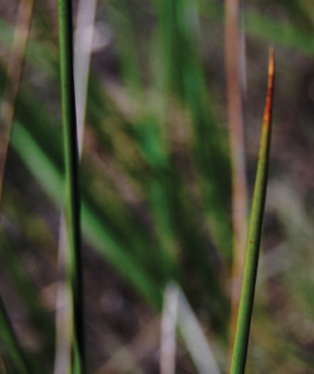

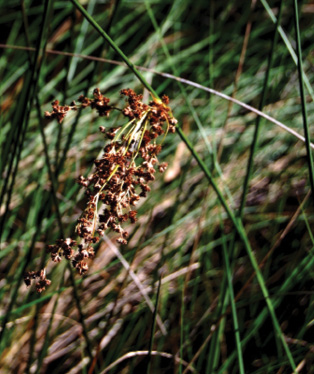
Scientific name: Spartina patens
Common name: Saltmeadow cordgrass
USDA plant symbol: SPPA
Naturally occurs in
- Irregularly flooded, fresh to saline marshes
- Sandy beaches and low dunes
- Borders of salt marshes and inland saline areas
Description
- Grows up to 4 feet tall
- Stems are stiff, slender, and hollow
- Leaves are up to 1 foot long and less than a half-inch wide
- Spreads by rhizomes
- Wind-pollinated flowers emerge from late June to October
Environmental tolerances
- Soils: fine to coarse
- pH range: 3.7 to 7.9
- Salinity: 0 to 35 ppt
- Elevation: mid to high marsh
- Flooding: irregular flooding
Planting
- Plant in mid to high marsh
- Space planting units 6 to 12 inches apart
- Plant using common garden hand tools
- Plant in late winter to early spring
Resources
- USDA Plants Database
- Mississippi Aquatic Plants
- Field Guide to Coastal Wetland Plants of the Southeastern United States (Tiner, 1993)


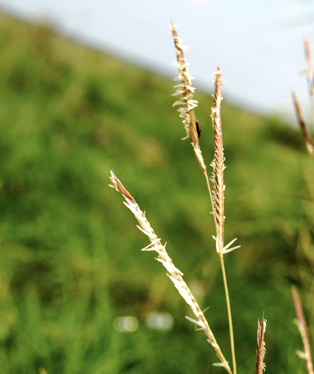
Scientific name: Juncus effusus
Common name: Common rush
USDA plant symbol: JUEF
Naturally occurs in
- Tidal fresh marshes and nontidal marshes
- Wet meadows and wet pastures
Description
- Grows up to 4 feet tall
- Stems are unbranched, round with vertical ribs, and sheathed
- No apparent leaves; has basal sheaths
- Can spread clonally by rhizomes
- Seeds emerge from July to September and can be spread by wind, water, or animals
Environmental tolerances
- Soils: fine sediments
- pH range: 4.0 to 6.0
- Salinity: less than 14 ppt
- Elevation: low to mid marsh
- Flooding: can tolerate regular flooding and standing water up to 6 inches
Planting
- Plant in regularly flooded soils or those with shallow standing water
- Plant in late fall
- Transplants survive best when planted outside of the growing season and when the soil remains saturated
- Space plants 2 feet apart
Resources
- USDA Plants Database
- Mississippi Aquatic Plants
- Field Guide to Coastal Wetland Plants of the Southeastern United States (Tiner, 1993)



Scientific name: Schoenoplectus americanus
Common name: Bulrush
USDA plant symbol: SCAM6
Naturally occurs in
- Irregularly flooded brackish marshes
- Upper edges of salt and tidal fresh marshes
- Inland saline areas
Description
- Grows up to 7 feet tall
- Stems are triangular with concave sides
- No apparent leaves
- Can spread by rhizomes or seeds
- Flowers from July to September
Environmental tolerances
- Soils: fine sediments
- pH range: acidic soils
- Salinity: 2 to 17 ppt
- Elevation: low to mid marsh
- Flooding: irregular flooding up to 1 to 2.5 feet, standing water up to 6 inches
Planting
- Space plugs or transplants 12 to 18 inches apart
- Plant in no more than 3 inches of constant flooding; can tolerate up to 18 inches of fluctuating water
- Plant in late spring to early summer
Resources
- USDA Plants Database
- Mississippi Aquatic Plants
- US Forest Service
- Field Guide to Coastal Wetland Plants of the Southeastern United States (Tiner, 1993)



Scientific name: Typha latifolia
Common name: Broadleaf cattail
USDA plant symbol: TYLA
Naturally occurs in
- Tidal and nontidal fresh marshes
- Ponds and ditches
Description
- Grows up to 10 feet tall
- Tall, erect stem
- Leaves are basal and up to 1 inch wide
- Can spread clonally by rhizomes or by seed
- Flowers from March to July
Environmental tolerances
- Soils: tolerates most soil types
- pH range: tolerates ranges from basic to acidic
- Salinity: fresh to brackish water
- Elevation: low marsh
- Flooding: regular flooding
Planting
- Plant in low to mid marsh
- Plant in late fall
- Plant transplants 3 feet apart
Resources
- USDA Plants Database
- Mississippi Aquatic Plants
- US Forest Service
- Field Guide to Coastal Wetland Plants of the Southeastern United States (Tiner, 1993)



Scientific names: Pontederia cordata
Common name: Pickerelweed
USDA plant symbol: POCO14
Naturally occurs in
- Tidal and nontidal fresh marshes
- Shallow areas of ponds and lakes
Description
- Grows up to 4 feet tall
- Waxy leaves at ends of stems
- Leaves range from oval to heart-shaped, 2 to 10 inches long, and 0.5 to 6 inches wide
- Spreads by creeping rhizomes and seed
- Seeds emerge between May and October on showy, purple flowers
Environmental tolerances
- Soils: tolerates a wide range from fine to coarse soils
- pH range: 6.0 to 8.0
- Salinity: less than 3 ppt
- Elevation: low marsh
- Flooding: tolerates irregular inundation up to 20 inches
Planting
- Transplants should be planted in saturated but not continuously flooded sediments
- Plant transplants in late spring to early summer
- Requires partial to full sun; will not grow in full shade
- Spreads rapidly; plant 2 to 3 feet apart
Resources
- USDA Plants Database
- Mississippi Aquatic Plants
- Field Guide to Coastal Wetland Plants of the Southeastern United States (Tiner, 1993)

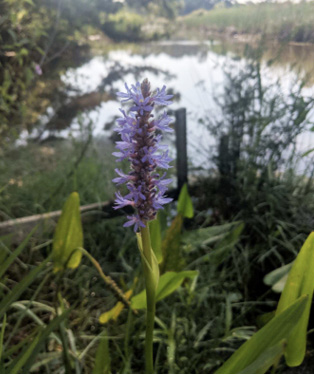

Scientific name: Sagittaria latifolia
Common name: Duck potato
USDA plant symbol: SALA2
Naturally occurs in
- Tidal and nontidal marshes and swamps
- Borders of streams, lakes, and ponds
Description
- Grows up to 4 feet tall
- Single, elongated stem
- Leaves are broadly or narrowly arrow-shaped
- Leaves are 2 to 16 inches long and 1 to 10 inches wide
- Spreads primarily by seed and vegetatively by underground tubers
Environmental tolerances
- Soils: tolerates a range from fine to coarse sediments
- pH range: 6.0 to 6.5
- Salinity: fresh to lightly brackish waters
- Elevation: low marsh
- Flooding: tolerant of inundation 6 to 12 inches deep
Planting
- Plant below high tide line
- Plant in mid to late spring
- In degraded sites, plant 1 to 2 feet apart
- In ideal site conditions, plant up to 6 feet apart
Resources
- USDA Plants Database
- Field Guide to Coastal Wetland Plants of the Southeastern United States (Tiner, 1993)

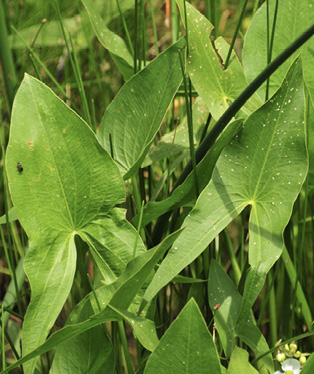

Scientific name: Distichlis spicata
Common name: Salt grass
USDA plant symbol: DISP
Naturally occurs in
- Irregularly flooded salt marshes
- Tidal fresh and brackish marshes
Description
- Grows up to 16 inches tall
- Stems are stiff, hollow, and round
- Leaves are numerous, 2 to 4 inches long, less than 0.5 inch wide, and rolled inward
- Spreads primarily by rhizomes and sometimes stolons
- Flowers between June and October
Environmental tolerances
- Soils: tolerates fine to coarse sediments
- pH range: 6.8 to 9.2
- Salinity: 0 to 50 ppt; optimum growth around 15 ppt
- Elevation: mid to high marsh
- Flooding: highly flood-tolerant but prefers irregular flooding
Planting
- Plant at or just below high tide line
- Plant in late spring to early summer
- Spreads rapidly; space transplants 3 to 5 feet apart
Resources
- USDA Plants Database
- US Forest Service
- Selected Plants of Grand Bay National Estuarine Research Reserve and Grand Bay National Wildlife Refuge
- Field Guide to Coastal Wetland Plants of the Southeastern United States (Tiner, 1993)



Scientific name: Ilex vomitoria
Common name: Yaupon
USDA plant symbol: ILVO
Naturally occurs in
- Upper edges of salt and brackish marshes
- Nontidal forested wetlands
Description
- Grows up to 28 feet tall
- Evergreen shrub
- Leaves are oval, dark green, and up to 1.25 inch long
Environmental tolerances
- Soils: will grow in a variety of soil types but prefers coarse sediments
- pH range: 4.5 to 7.0
- Salinity: moderately tolerant to salinity and salt spray
- Elevation: high marsh
- Flooding: tolerates occasional flooding
Planting
- Most easily established by using transplants
- Plant in spring and fall
- Space about 20 feet apart
- Plant on upper edges of marsh above high tide line
Resources
- USDA Plants Database
- Field Guide to Coastal Wetland Plants of the Southeastern United States (Tiner, 1993)



Scientific name: Baccharis halimifolia
Common name: Eastern baccharis
USDA plant symbol: BAHA
Naturally occurs in
- Upper edges of irregularly flooded salt, brackish, and tidal fresh marshes
Description
- Grows up to 10 feet tall
- Deciduous shrub
- Egg-shaped, coarse-toothed to smooth leaves, up to 2.5 inches long
- Easily confused with Iva frutescens (marsh elder), but eastern baccharis has alternate leaves, while marsh elder has opposite leaves
Environmental tolerances
- Soils: tolerates a wide range of soils from fine to coarse
- pH range: 5.0 to 8.0
- Salinity: tolerates salt spray up to 15 ppt
- Elevation: high marsh
- Flooding: tolerates irregular flooding but cannot survive standing water
Planting
- Plant shrubs at least 7 feet apart
- Plant on upper edge of marsh above high tide line
- Plant in early to late spring
Resources
- USDA Plants Database
- Selected Plants of Grand Bay National Estuarine
- Research Reserve and Grand Bay National Wildlife Refuge
- Field Guide to Coastal Wetland Plants of the Southeastern United States (Tiner, 1993)

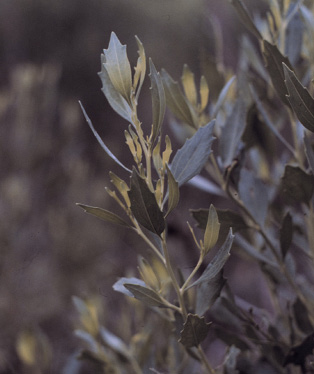

Scientific name: Uniola paniculata
Common name: Sea oats
USDA plant symbol: UNPA
Naturally occurs in
- Upper dunes along beachfronts
- Barrier islands
Description
- Grows up to 6 feet tall
- Leaves can grow up to 24 inches
- Leaves less than 1 inch wide
- Seed head produced in summer
- Spreads primarily by rhizomes when plant base is covered by sand
Environmental tolerances
- Soils: prefers coarse, sandy sediment
- pH range: 6.9 to 7.9
- Salinity: thrives in salt spray but cannot tolerate waterlogged soils
- Elevation: upland sand dunes
- Flooding: requires dry conditions
Planting
- Space plantings 2 to 5 feet apart
- Plant any time of year
- Plant on upland berms in sand
Resources

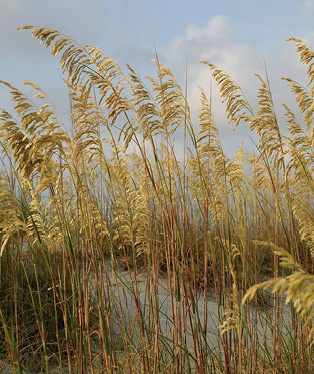

Scientific name: Panicum amarum
Common name: Bitter panicum
USDA plant symbol: PAAM2
Naturally occurs in
- Coastal dunes
Description
- Grows up to 7 feet tall
- Leaves are 0.25 to 0.5 inch wide and 7 to 20 inches long
- Leaves are bluish-green
- Spreads extensively by rhizomes to form clumps
Environmental tolerances
- Soils: dry, sandy soils
- pH range: 5.0 to 7.5
- Salinity: can tolerate salt spray but will not survive waterlogged soils
- Elevation: upland on dunes
- Flooding: needs dry conditions
Planting
- Can grow from stem cuttings in fall
- Can grow in late winter or early spring with potted plants
- Plant 2 to 3 feet apart in staggered rows 2 feet apart
Resources

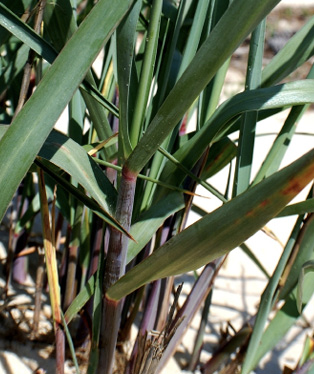

Scientific name: Iva frutescens
Common name: Marsh elder
USDA plant symbol: IVFR
Naturally occurs in
- Upper borders of irregularly flooded salt and brackish marshes
Description
- Deciduous shrub
- Grows up to 12 feet tall but usually about 6 feet tall
- Fleshy, egg-shaped leaves grow up to 6 inches long and
- 2 inches wide
- Often confused with Baccharis halimifolia (eastern baccharis), but marsh elder has opposite leaves, while eastern baccharis has alternate leaves
Environmental tolerances
- Soils: tolerates a wide range of soils from fine to coarse
- pH range: 5.0 to 5.7
- Salinity: 0 to 15 ppt
- Elevation: high marsh
- Flooding: needs dry soils
Planting
- Grow from seed, propagate from bare root, or transplant from containers
- Not flood-tolerant, so plant on the very upper edge of the marsh
- Plant at least 6 feet apart
- Requires full sun
- Plant in early to mid-spring after last frost
Resources

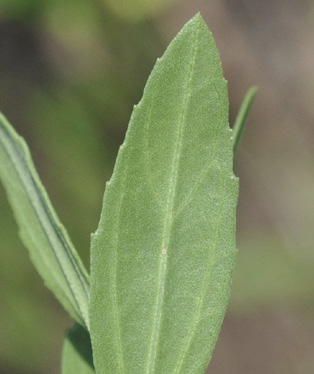

Scientific name: Myrica cerifera
Common name: Wax myrtle
USDA plants symbol: MOCE2
Naturally occurs in
- Upper edges of tidal salt, brackish, and fresh marshes
- Irregularly flooded tidal and nontidal swamps
Description
- Evergreen shrub or tree
- Grows up to 36 feet tall but usually 10 to 15 feet tall
- Smooth, grayish-green bark
- Leaves are oblong and grow up to 3.75 inches long and 1 inch wide
Environmental tolerances
- Soils: tolerates a wide range from fine to coarse
- pH range: 5.0 to 7.2
- Salinity: 0 to 10 ppt
- Elevation: high marsh
- Flooding: tolerant of both drought and flooding once established
Planting
- Grow from seed, propagate from bare root, or transplant from containers
- Plant in the upper edge of the marsh
- Plant in late winter to early spring
- Space about 10 feet apart
Resources
- USDA Plants Database
- Field Guide to Coastal Wetland Plants of the Southeastern United States (Tiner, 1993)
- Chesapeake Bay Native Plants Center

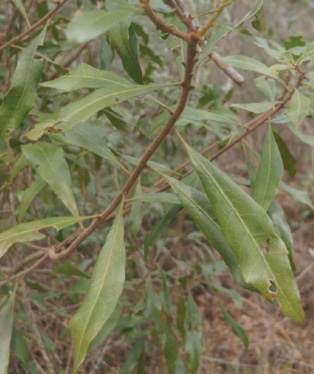

Scientific name: Sagittaria lancifolia
Common name: Bulltongue arrowhead
USDA plant symbol: SALA
Naturally occurs in
- Fresh wetlands
- Ponds and ditches
Description
- Grows up to 3 feet tall
- Leaves are elongate, oval- to lance-shaped
- Leaves are 8 to 24 inches long
- White flowers emerge March to October
Environmental tolerances
- Soils: tolerant of a wide range from fine to coarse
- pH range: 6.0 to 7.2
- Salinity: 0 to 5 ppt
- Elevation: low marsh
- Flooding: can tolerate up to 12 inches of consistent flooding
Planting
- Can grow from seed or divided clumps, but transplanting from corms is preferred
- If transplanting, space 10 to 12 inches apart
- Prefers full sun
- Best if corms are planted when plants are dormant in late fall to early spring
Resources
- USDA Plants Database
- Mississippi Aquatic Plants
- Florida Native Plant Society
- University of Florida IFAS Extension
- Selected Plants of Grand Bay National Estuarine Research Reserve and Grand Bay National Wildlife Refuge

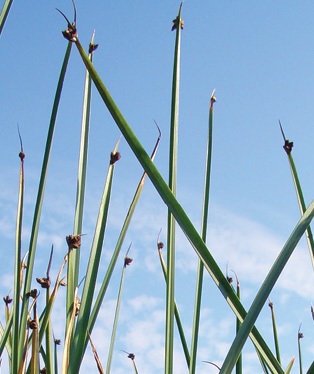

P3356 (POD-02-23)
MASGP-19-030
By Sara Martin, Extension Associate, and Eric Sparks, PhD, Assistant Extension Professor, Coastal Research & Extension Center.

The Mississippi State University Extension Service is working to ensure all web content is accessible to all users. If you need assistance accessing any of our content, please email the webteam or call 662-325-2262.



